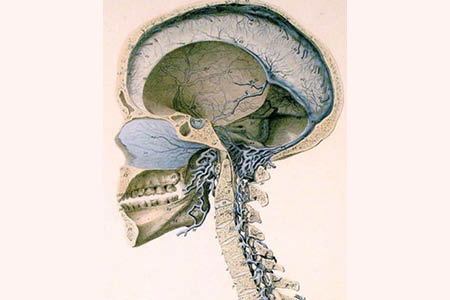Ageing is a major risk factor for many neurological pathologies, but its me- chanisms remain unclear. Unlike other tissues, the parenchyma of the central nervous system (CNS) lacks lymphatic vasculature, and waste products are removed partly via the paravascular route. The (re)discovery and characterization of meningeal lymphatic vessels have prompted an assessment of their role in waste clearance from the CNS. Alzheimer’s disease is the most prevalent cause of dementia.
Meningeal lymphatic drainage has an important role in the accumulation of amyloid beta (Aß) in the brain1,2, while the outcome of any modulation of the meningeal lymphatic function is not known.
Furthermore, the dural sinuses act as a neuroimmune interface, where brain antigens are monitored under steady-state conditions.
A very recent experimental study, published in Nature5, reported that the ablation of meningeal lymphatic vessels in 5xFAD mice – a mouse model of amyloid deposition that expresses five mutations found in familial Alzheimer’s disease – worsened the outcome in mice through:
-
| exacerbation of the deposition of amyloid beta (Aß);
-
| microgliosis;
-
| neurovascular dysfunction;
-
| behavioural deficits.
-
5xFAD mice at 12–13 months of age show a significant decrease in lymphatic vessel coverage along:
-
| the superior sagittal sinus (SSS);
-
| the transverse sinus (TS);
-
| the confluence of sinuses (COS) in the meninges.
In contrast, the petrosquamosal and sigmoid sinuses appeared the same as in healthy mice. Notably, the application of vascular endothelial growth factor C (VEGF-C) – a potent pro-lymphangiogenetic factor – improved the clearance of amyloid beta (Aß).Treatment of aged mice with VEGF-C enhances meningeal lymphatic drainage of macromolecules from the cerebrospinal fluid, improving brain perfusion and learning/memory performance.
Based on these experimental observations, the following can be postulated in the year 2022:
-
| Meningeal lymphatic dysfunction may be an aggravating factor in Alzheimer’s disease pathology and in ageassociated cognitive decline.
-
| Thus, augmentation of meningeal lymphatic function might be a promising therapeutic target for preventing or delaying ageassociated neurological diseases.
ESWT AND THE PERIPHERAL LYMPHATIC SYSTEM
Extracorporeal Shock Wave Therapy (ESWT) uses acoustic waves to elicit a biological response via mechanotransduction. A number of publications have evaluated the effect of ESWT on the lymphatic system in promoting the growth of lymphatic vessels and reduction of lymphoedema.We performed a systematic metaanalysis to evaluate all experimental and clinical studies on ESWT on the lymphatic system for indications including primary and secondary lymphoedema, lipoedema, cellulite and fibrosis/scarring.
-
| #lymphedema
-
| #shock wave therapy
-
| #cellulite
-
| #fibrosis
-
| #lymphangiogenesis
within the MEDLINE, EMBASE and PubMed databases and the Cochrane Lib- rary. The relevant data were extracted and analysed in detail, in accordance with Preferred Reporting Items for Systematic Reviews and Meta-Analysis (PRISMA) recommendations. Fiftyfour full papers were identified based on the above-mentioned search terms.
-
| In animal experiments using a lymphatic rabbit ear model, focused ESWT (12 sessions, 0.09 mJ/mm2) improved lymphatic vascular endothelial growth factor C (VEGF-C) significantly, and reduced ear swelling. Focused ESWT accelerated lymphangiogenesis. It exerts antifibrotic effects by modulating the transforming growth factor beta (TGF-ß) pathway.
-
| In a clinical cohort study9 performed in 2005, involving 26 females with lipoedema and cellulite, it was found that focused ESWT (0.016 mJ/mm2, 1,000 shots, 3–6 sessions) reduced lipoedema and the extent of cellulite significantly. Notably, the more ESWT sessions that were applied, the better the elasticity. Twelve clinical studies (including five randomized controlled trials) have been published on the use of ESWT to treat cellulite; these will be evaluated separately in a meta-analysis.
-
| In secondary lymphoedema of the upper extremity in breast cancer and axillar lymphonectomy, both radial and focused ESWT have been reported to be successful in terms of swelling reduction and pain improvement. South Korea-based authors Bae & Kim10 reported a 37 % reduction in arm swelling after four sessions of focused ESWT (0.056 mJ/mm2) electrohy draulic focused ESWT, 2,000 shots). In a study conducted in Turkey, Cebicci11 described how 12 sessions of radial ESWT proved successful in treating secondary lymphoedema, with a 31 % improvement in swelling.
ESWT FOR ENHANCED BRAIN LYMPHATIC CLEARANCE
The above-mentioned observations can be summarized as follows:
-
| Meningeal lymphatic dysfunction may be an aggravating factor in
Alzheimer’s disease pathology and in ageassociated cognitive decline;
-
| Augmentation of meningeal lymphatic function might be a promising therapeutic target for preventing or delaying ageassociated neurological
diseases;
-
| Extracorporeal Shock Wave Therapy (ESWT) has been clinically shown to
improve lymphangiogenesis by means of VEGF-C stimulation, facilitate swelling reduction in lymphedema and reduce pain in lymphatic disorders.
ESWT FOR ENHANCED BRAIN LYMPHATIC CLEARANCE
The above-mentioned observations can be summarized as follows:
-
| Meningeal lymphatic dysfunction may be an aggravating factor in
Alzheimer’s disease pathology and in ageassociated cognitive decline;
-
| Augmentation of meningeal lymphatic function might be a promising therapeutic target for preventing or delaying ageassociated neurological
diseases;
-
| Extracorporeal Shock Wave Therapy (ESWT) has been clinically shown to
improve lymphangiogenesis by means of VEGF-C stimulation, facilitate swelling reduction in lymphedema and reduce pain in lymphatic disorders.
These observations suggest there may be grounds for speculation that ESWT targeting the brain lymphatic system is feasible and safe. In my own use of Transcranial Pulse Stimulation (TPS®), I began to combine focused ESWT with TPS® and radial pressure wave therapy during the same session.
THE PROCEDURE I ADOPT
-
| TPS® as applied to the major sinuses:
-
| Superior sagittal sinus (SSS): 0.15–0.2 mJ/mm2; 1,000 shots
-
| Transverse sinus (TS): 0.15–0.2 mJ/mm2; 500 shots
-
| Confluence of sinuses (COS) in the meninges: 0.15–0.2 mJ/mm2;
500 shots
-
-
| Radial pressure wave therapy at 0.7–1.1 bar, 8–12 Hz, 2,000 shots
applied to the neck
Much more interesting informations:
Karsten Knobloch, Tomáš Nedělka
ESWT in Neurology
402 Seiten, in englischer Sprache
ISBN 978-3-945106-13-6
EUR 75,00
Bestellungen unter:

Jetzt informieren: Level-books.com
